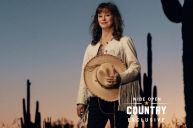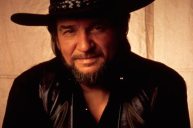Sometimes we need to look to the past in order to move forward. Providence, Rhode Island based musician and scholar Jake Blount does just that on his latest project The New Faith, a 12 song concept album out Sept. 23 via Smithsonian Folkways Recordings imagining a dystopian future crippled by climate change that follows a group of refugees as they trek from the flooded and inhabitable southern United States to more habitable islands off the coast of New England.
Bringing this story to life are old hymnals reimagined and reinterpreted to fit Blount's narrative including Bessie Jones "Once There Was No Sun" and traditionals "The Downward Road" and "Didn't It Rain." Each song was hand-picked by Blount due to the solace they've long given him.
According to Blount, as well fleshed out as the concept for The New Faith became, it wasn't one he'd been marinating on until Smithsonian Folkways Recordings approached him about working together on a concept album in the summer of 2020. As a result, he ended up presenting the label with a couple different story concepts to pursue before both parties agreed to proceed with a harrowing tale of refugees escaping the extreme grips of climate change. From there it was about finding the right hymnals to convey this message without having to completely turn them upside down.
"It was all about thinking of the concept, thinking of the songs I knew and what about each of them could apply to the concept I was striving for without needing to be changed," Blount tells Wide Open Country. "I ended up having to change some words here and there, but I was always careful not to alter the structure of the songs very much."
An example of this comes on "The Downward Road," where Blount altered the lyrics to tell a story of how the refugees depicted throughout the record got to the position they were in, a far cry from the song's original tone of "my sister won't stop gambling, she's going to hell."
As Blount was meticulously selecting the songs for the album and recording them he quickly noticed how they were naturally grouping themselves together. He ultimately embraced this discovery by officially categorizing them on The New Faith under "The Psalms Of The Sentinel," "The Psalms Of The Gravedigger" and "The Psalms Of The Teacher." Tracks "Parable" and "Psalm" help to start the latter two "chapters" of the album as Blount uses the space to chronicle the refugees' journey, from trials faced to lives lost along the way.
"They kind of separated themselves," says Blount about how each of the album's psalms developed. "It's not something I went into recording expecting to happen. When I got about half of the project finished I began to notice how the songs were naturally grouping themselves into these categories, which the anthropologist in me loved. I ended up adding the spoken word pieces to further separate each section up and provide context to the album's overarching story, but at the end of the day it was just a logical way of breaking things up."
Throughout each of the three psalms a large sonic and geographical influence is Cushing Island, Maine. Blount and his team ended up recording ambient and drone footage there heard all over the project, helping to set the landscape for the plot of land that the album's main characters have in their crosshairs. In a future dismantled by climate change, Blount sees the northeastern United States being some of the only habitable land left in the country, leading to a mass migration of people there from the south as water, food and a livable climate become more and more scarce.
"It also made sense that they'd be confined to refugee camps when they got there because historically when governments have been faced with large amounts of Black and Brown people they've found ways to sequester them onto small, less than ideal tracts of land," says Blount. "It gave me this idea that due to increased storm activity and sea level rise, the islands off the coast of New England would likely be abandoned by the wealthy, white vacationers who once called them home, making it the perfect spot for these refugees to set up camp."
Despite the dark future portrayed on The New Faith, the album still rings with positivity. This is exemplified by the joyous harmonies on "Once There Was No Sun," a Bessie Smith cover that Blount coincidentally filmed a music video for on the aforementioned island off of Maine's coast. This overarching sense of triumph is heard through the lens of multiple musical styles from traditional bluegrass to muddy Mississippi blues, hip-hop, gospel and more.
"It wouldn't have made sense to only stick with one style that exists today if I'm imagining music taking place two or three centuries from now," says Blount. "The idea is that the people portrayed on this record would've heard all of the music we had but without all of the tools to listen to or reproduce them in the same way."
This led to the album's sounds being dictated by what Blount anticipated being realistic to what instruments and equipment people would have available in his envisioned future. This meant no electric guitars on the album since access to electricity in his alternate universe would be hard to come by, if not non-existent, along with more handmade percussion and layered harmonies since voices would likely be the most consistent source of sound.
This meant all types of vocal practices were on the table, including rap, especially with how pivotal a role it has had in the Black music experience for decades. For this, Blount reached out to Greensboro, North Carolina based artist Demeanor, who ended up contributing rap interludes on "The Downward Road," Vera Hall's "Death Have Mercy" and "Give Up The World." Originally Blount intended on recruiting several rappers for the project before coming to the conclusion that Demeanor alone was the right fit.
"It's difficult to find rappers who are well versed in the sounds I work with," says Blount. "Demeanor also plays the banjo, so he has a lot of familiarity with the style and how to effectively rap over it. It was easy to send him songs to work on because it wasn't out of his wheelhouse at all. He knew what he was doing and did a great job bringing his contributions on the record to life."
Recorded remotely at the height of the COVID-19 pandemic in the summer of 2020 between his grandparent's homes in Maine and Virginia, Blount's The New Faith is easily the artist's most wide-ranging and polished effort today, quite the feat considering how acclaimed his previous releases, Spider Tales and Reparations, have been.
Even though it was his first time recording a concept album, his first time recording in isolation and his first time recording for Smithsonian Folkways Recordings' African American Legacy Series, Blount's third record The New Faith is prime evidence that the best things come in threes. The album builds off his two critically acclaimed predecessors to paint a story of triumph, tribulation and hope over a vibrant canvas of the future, albeit a less than ideal one.
"This is more of an exploratory album rather than a didactic one," says Blount. "For me, I didn't try to go into it trying to teach people anything. It was just me thinking about one possible future. However, if people listen to it and are inspired to do better then I'm happy with that."
READ MORE: Kendell Marvel Lets A Little Light In On 'Come On Sunshine'




